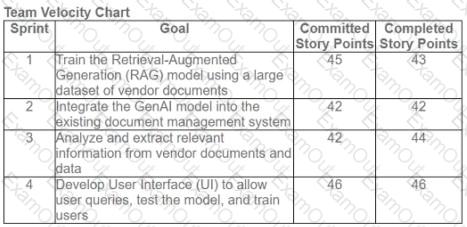A team retrospective was going well until the team lead introduced the "define the next experiment" topic; then the discussion became an argument. A new team member feels strongly that the approach used on their previous team would improve this team's efficiency and effectiveness. The team lead is adamant that they remain with the current approach and the discussion dissolves into a circular argument.
A development team and product owner disagree on a user story in the product backlog. What should the agile practitioner do?
During planning, a project team and sponsor created a visual representation of the high-level specifications of the features and user stories to be implemented in a product. Consensus was achieved on this high-level depiction of the product characteristics, but the sponsor is having difficulty understanding what to develop and when.
How should the project manager explain this to the customer and save time in the meeting?
Based on the backlog metrics in the chart, what can explain the jump in points at the end of iteration 4?

A newly formed team is struggling to work together and agree on how to complete tasks in the upcoming sprint. What should the scrum master do to support the team?
A scrum master is working with a team on a complex software project that is scheduled to run for 2 years with a series of product releases. The scrum master is responsible for planning the project for the next 6 months and has advised planning the project up front.
What should the scrum master do?

The team is considering committing to 44 story points for the upcoming sprint. Based on the
velocity chart, what advice should the scrum master offer the team?
A new team member asks what changes could accelerate a change to the project plan.
What should be the proper response?
The team underestimated the complexity of a story, resulting in new decomposition of the work to be delivered in the current sprint and items to be returned to the backlog. What should the Scrum Master do next?
A new agile team member notices that the team's current process involves excessive documentation. What should the new team member do?

